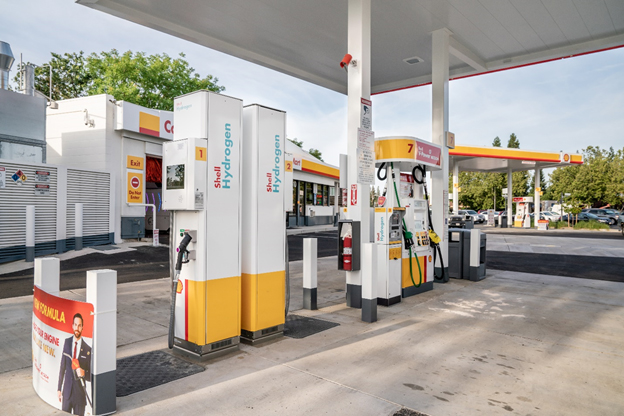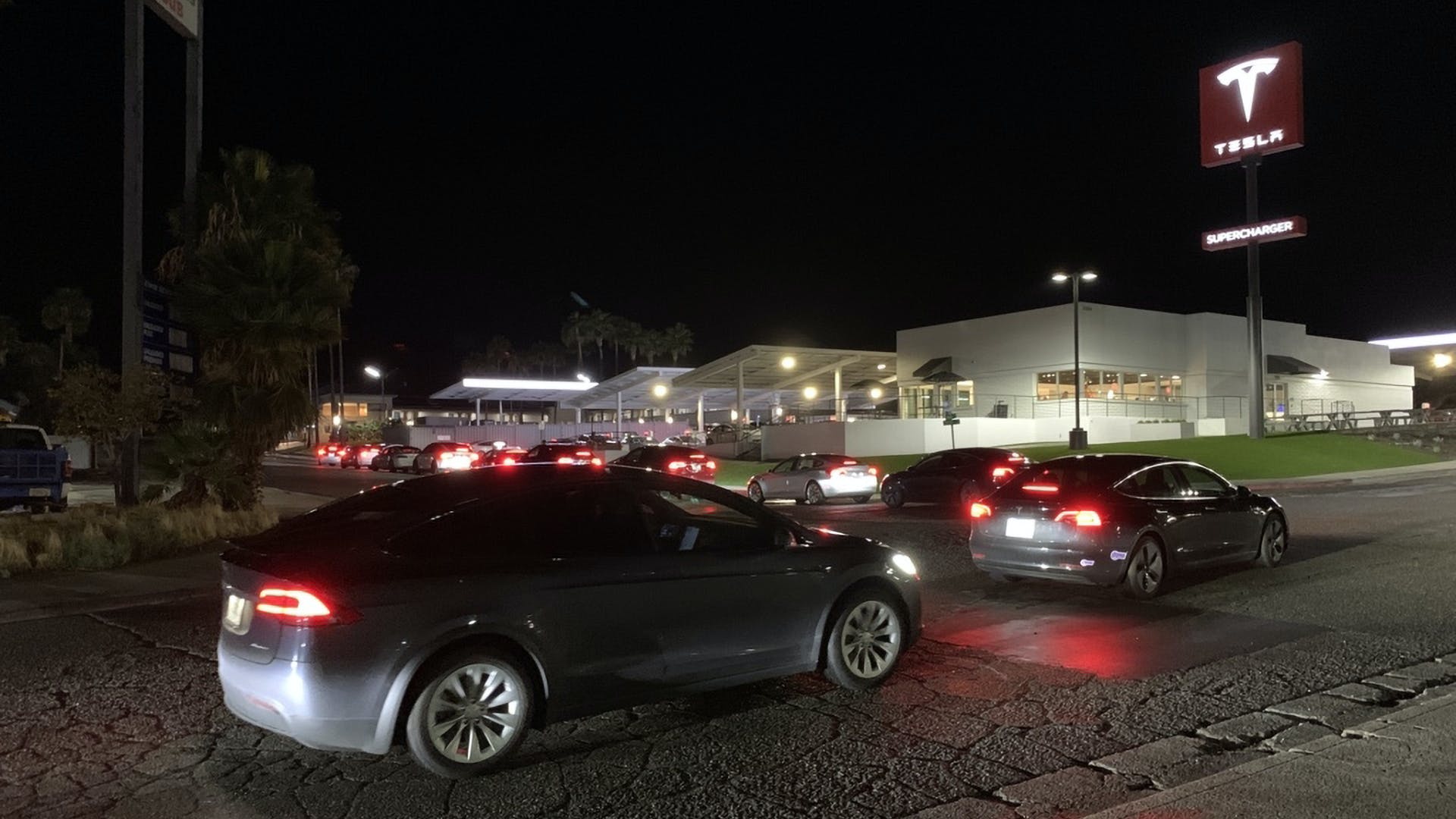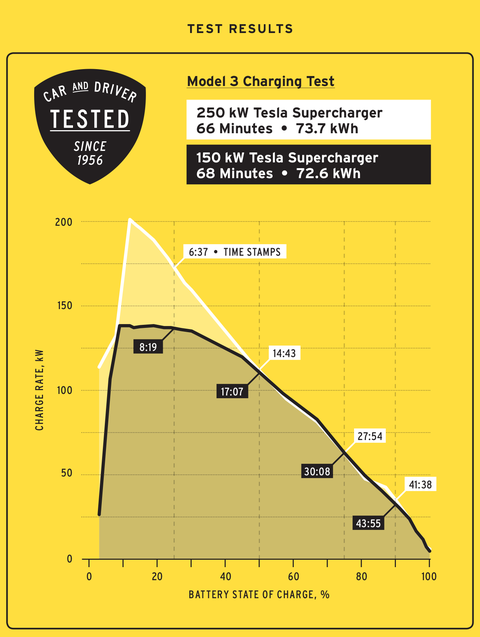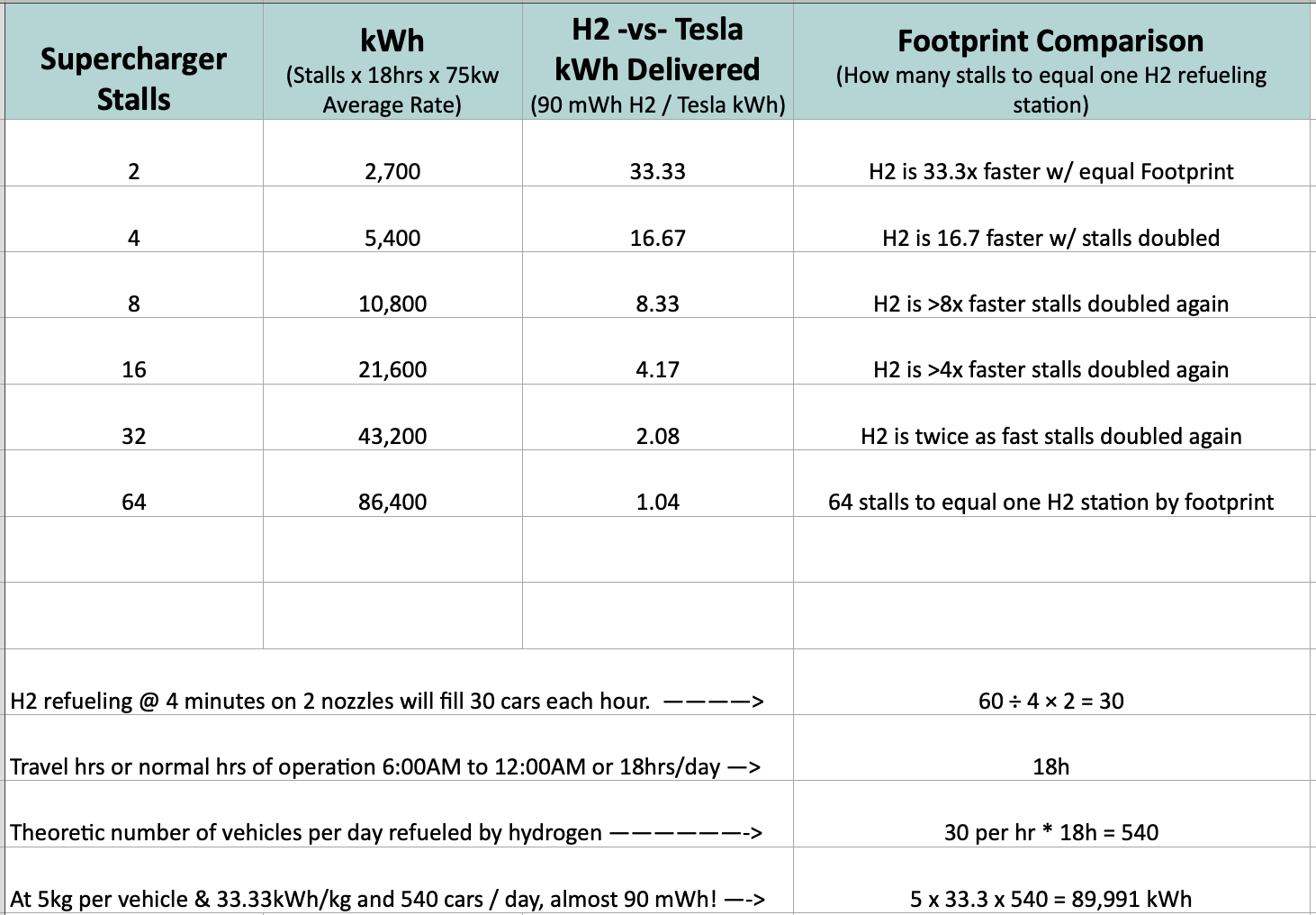Hydrogen pairs well economically with 100% renewable energy like wind, solar, and biogas for fast recharging of zero emission vehicles like cars, trucks, busses, trains, & boats. Wind & solar can have large footprints that make them hard to site near areas where there are large populations of people or where large scale refueling/recharging must take place. RMP has written many times about how solar arrays & wind farms can often produce terawatts of energy each year that go wasted because the electricity produced couldn’t be used when it was made. Wasted energy stranded like this is called curtailed energy. Modern grids have to balance electricity production to usage and must choose to dump electricity if it can’t be used. More and more projects around the world are demonstrating power to gas is an economical way to store that otherwise wasted energy as hydrogen so we can get it back whenever we need it.
One of the knocks against hydrogen refueling anti-hydrogen folks continue to use against hydrogen is to say there are only 95 hydrogen refueling stations across America compared to thousands of locations where a BEV can be fast charged. Given we are early in the transition to electrified propulsion, it’s important to think about the overarching goal of zero emission vehicles: to use clean renewable energy to power our transportation sector & reduce harmful emissions. Even though there are more fast charging stations than the 95 hydrogen fueling stations right now in the USA, there are already 13 hydrogen stations that use 100% renewable energy. Contrast that to the 908 Tesla Supercharger locations across the USA open today and note that not a single one of those 908 Supercharger locations is 100% off-grid solar, wind, or biogas. Not one. 0%. As we kick off this article, let’s put this important statistic up on the scoreboard when it comes to the number of 100% renewable refueling/recharging locations in the USA: Hydrogen 13 – Tesla Superchargers 0.
This important point of delivering 100% clean energy for our transportation sector is becoming increasingly more relevant as time goes by. Advocates of zero emission vehicles have a stated goal to move away from fossil fuels and reduce emissions to zero across the board. Without a single demonstration of fast charging paired with 100% renewable solar or wind to see how it works, we are left for years now to guess how it will ever get done. If all fast charging stations eventually need to get to 100% clean energy shouldn’t anti hydrogen folks show us the cost & footprint & specs of one station so we can see how it works?

According to Modernize, less than a handful of states have produced better than 20% of their energy from renewable energy sources. Many states, like New Mexico, Kansas, Utah, Indiana, Ohio, and more get over 90% of their energy from dirty fossil fuel sources like coal, oil, & natural gas. Manufacturing & charging electric vehicles off a dirty grid isn’t making a dent in CO2 emission reductions. When can we fast charge BEVs with clean off-grid renewable energy? Does the possibility even exist? Or is it still a fantasy?
Unfortunately, hydrogen & batteries get looked at as some sort of death match of competitive technologies that leave us with an either/or decision of what technology to use, but it really shouldn’t be that way. RMP has written for years about how it’s a red herring argument to say we have to choose only one technology. Hydrogen & batteries work very well together; we really need both technologies to phase out crude oil, coal, and natural gas. Even though hydrogen & batteries should be thought of technologies that cooperate, it’s human nature for people to have some fun with friendly competition. In the spirit of friendly competition, let’s look at why hydrogen refueling has a big advantage over battery charging alone when it comes to renewable energy for fast recharging. If our goal is 100% renewable energy it’s important to keep this score in mind: Hydrogen 13 – Tesla Superchargers 0.
While there is a lot of promise for BEV vehicles for good reason, there is also an elephant in the room: fast charging throughput is about 20:1 slower than refueling with gasoline. Because hydrogen refueling is on par with gasoline, it means hydrogen fueling is also about 20:1 faster than the fastest Tesla Supercharging. According to a quick Google search, it takes about 75 minutes to charge a Tesla to 100% state of charge with a 150 kW Supercharger. It takes between 3 to 4 minutes to fill up a gasoline or hydrogen car. 75 divided by 3 = 25:1 and 75 divided by 4 = 18.75:1. Hydrogen’s throughput capability is a big deal when scaling to millions of vehicles because it stands to reason capital allocation of renewable energy tax subsidy dollars would also be leveraged 20:1 if spent on hydrogen infrastructure. If the goal is to refuel as many vehicles in the shortest amount of time possible on busy travel routes, hydrogen is the clear winner. We’ve all seen the videos & read the stories about Teslas backing up at Superchargers during Thanksgiving. So called fast charging is already showing failure with less than 1% of vehicles on the road using it; this is very bad for scaling up.
Even if we do decide to spend our tax subsidy dollars on battery recharging infrastructure at a 20:1 disadvantage vs hydrogen, we still don’t get fast charging from renewable energy because it doesn’t exist. We don’t even know the cost of off-grid 100% renewable fast charging. All we can say with utter certainty is that hydrogen refueling is way faster than battery charging.

For three years (since 6/9/2017) we’ve been waiting for the very first example of off-grid 100% renewable Supercharging. Its starting to appear, however, that battery fast-charging just isn’t compatible with 100% renewable off-grid energy. The best way to charge a battery with 100% renewable off-grid energy will probably be to use a fuel cell system. The two technologies are truly meant for each other and bound to each other’s service. Fuel cells & their battery cousins shouldn’t even be thought of in competition, but rather technologies that compliment each other.
June 9, 2020 marks the three year anniversary of Elon Musk tweeting that “All Superchargers are being converted to solar/battery power. Over time, almost all will disconnect from the electricity grid”. Elon Musk likes to use ambiguous words like “all” and “soon” so often that a pattern has emerged. A growing chorus of people has started showing & tweeting examples of how Elon Musk is not much different than the Wizard of Oz: just a man shining people on with false promises from behind the curtain. We get promises & rhetoric of all these great things coming in order to win tax subsidies & venture capital funding from Wall Street billionaires, but the promises never materialize for working class people on main street. The mansions and private jet are real, but off-grid renewable Superchargers… well, not so much…
All Superchargers are being converted to solar/battery power. Over time, almost all will disconnect from the electricity grid.
— Elon Musk (@elonmusk) June 9, 2017
Elon’s false promises are becoming so obvious websites have emerged to demonstrate how Elon Musk is shining people on in order to raise money for his billionaire lifestyle. It’s important to stay vigilant in making sure our tax dollars are being used responsibly to further our migration from fossil fuels to renewable zero emission technology. If our tax subsidy money is going toward a company like Tesla & the goods are not getting delivered, we need to hold that company accountable to their promises made for our tax dollars. We need to see results. We cannot continue to be fed constant promises that are always years away and never materialize. We need to see real growth in the demonstration of true zero emissions or we gotta call BS. It’s been 3 years since Elon said Superchargers were in the process of being converted to off-grid solar but still when we look up a the scoreboard it’s: Hydrogen 13 vs Tesla Superchargers 0.
There are three major types of air pollution caused by our transportation sector: 1) Carbon Dioxide Emissions, 2) NOx Emissions & 3) Sulphur Dioxide Emissions. Further, most people want to focus on what’s called the well-to-wheel emissions meaning that we have to account for all emissions including manufacture & distribution of the energy to make the vehicle as well as the energy we use on a daily basis like coal & natural gas power plants. For a great example of why hydrogen fuel cell vehicles are better than battery electric vehicles at overall well-to-wheel emissions, the best comparison is the new Toyota RAV4 Prime. The RAV4 Prime in this post’s feature image is a gasoline plug-in hybrid electric vehicle (PHEV). The RAV4 Prime is a good example that demonstrates why Toyota, Honda, & Hyundai are so confident about hydrogen fuel cell vehicles working along side batteries in the future as a range extender. While the “range extender” of the battery in the RAV4 Prime is an internal combustion engine, that “range extender” will easily be replaced by a Toyota fuel cell in markets developing hydrogen refueling infrastructure.
According to a quick Google search, the Toyota RAV4 Prime PHEV going on sale in a couple months will average about 29g of CO2 per kilometer. The Tesla Model 3 averages about 170g of CO2 per kilometer. This stark difference goes unnoticed by many Tesla cheerleaders in the anti-hydrogen crowd. Let’s think about that for minute: a full size gasoline plug-in electric hybrid SUV with off-road ruggedness & three to four minute refueling will produce nearly 6 times less CO2 than a Tesla Model 3 that takes hours to charge & can have its warranty voided if you drive down a dirt road. Furthermore, if CO2 emissions are lower in the PHEV by a factor of six, it stands to reason SOx & NOx (smog) are also reduced by a similar multiple. The RAV4 Prime seems like a no brainer to an average consumer that wants lower emissions from overnight charging. The RAV4 Prime also comes with no long waits at the fast charger on road trips. The PHEV is comparable in price, has more convenience & utility, and is also the best for overall air quality.
You’d think that with such a large emissions advantage over the Tesla Model 3 that you’d have to pay an arm & a leg to buy the bigger & more functional Toyota RAV4 Prime over the smaller Tesla sedan, but you’d be wrong again. The Toyota RAV4 Prime base model is loaded with features like All Wheel Drive, 8-way power seats, power back door, & Apple Carplay and will sticker at about $38,100. The Tesla Model 3 standard range car stickers at $39,990 and only has a range of 250 miles. The Toyota is also getting a tax subsidy of $7,500 off the sticker price so it’s more like $30,600 for the Toyota RAV4 Prime -vs- $39,990 for the standard Model 3.
Most drivers will drive 95% of their average miles without using gasoline using the Toyota RAV4 Prime, but they will have the gasoline “range extender” for cross country trips without any slowdown to what they’re already used to with a gasoline vehicle. This is how Toyota gets such a large clean air emissions advantage per kilometer over the Tesla. It’s because the Toyota only has a 17.8 kWh battery while the standard range Tesla Model 3 has a 54 kWh battery. The larger extra kilowatt hour battery penalizes the Tesla on manufacturing emissions while the under 20 kWh battery in the Toyota is enough for 95% of people’s average daily driving. Lithium, cobalt and manganese for making batteries are mined and processed with high-energy input. A battery for a Tesla Model 3, for example, pollutes the climate with about 11 to 15 tons of CO2. With a battery life of ten years and a mileage of 15,000 kilometres per year, that alone would mean 73 to 98 grams of CO2 per kilometer, according to Autovista Group.
But wait a minute, this article is about hydrogen fuel cell vehicles and RMP is comparing a gasoline PHEV to BEV. Hydrogen refueling is not as prevalent or available as gasoline refueling or battery charging, this is true. It’s also true that we are in the very early innings of both technologies. There was also a time in America’s relatively short history when there were no gasoline stations, no airports, and no train stations. Hydrogen refueling stations can be built and are being built around the world right now and they’re proliferating rapidly. Toyota knows the switch to electric powertrains is a long term game and they also know how to pair a battery with a hydrogen fuel cell. Toyota can very easily swap the gasoline fueled internal combustion engine in a vehicle like the Toyota RAV4 Prime with a hydrogen fuel cell system as hydrogen stations build out in markets around the world. And that’s the end game: smaller batteries coupled with hydrogen fuel cell propulsion systems. Honda already has a platform called the Clarity that’s compatible with all three propulsion systems: plug-in hybrid, hydrogen fuel cell, and battery electric.
Because we are in the early innings of building new energy infrastructure it’s important to look at how things are going to scale up to meet our energy hungry needs. We know hydrogen refueling works with 100% renewable energy for refueling but we have no examples of how battery electric fast charging can do the same. How can we calculate the cost of all the 100% renewable fast charging locations without knowing the cost of one? At its core, this is the whole concept of scaling energy: make something once & repeat ad infinitum. It’s like aiming for the moon from the earth, if your calculation is wrong as you set out on your trip, by the time you’ve travelled all the way to the moon you’ll have missed by several miles.

Let’s go through some quick number comparisons using time, kilowatt hours, and kilograms of hydrogen to try to draw some comparisons mathematically. First off, let’s note that there are 33.33 kWh of energy in 1 kilogram of hydrogen. Several new hydrogen refueling stations in California slated to open later this year will have a capacity of 1,200 kg of hydrogen. 1,200 x 33.33 = about 40 megawatt hours. A regular hydrogen passenger vehicle will hold about 5 kg of hydrogen. Therefore, the station’s nameplate capacity will fill about 240 cars. The 1,200 kg capacity hydrogen station can be refilled and just keep on refueling cars, so it’s really not limited to 240 cars. The larger capacity just makes refueling the station itself less cumbersome. Let’s look at our hydrogen station differently. Let’s say it has dual dispensers & the station was open during the travel hours of 6AM to 12AM or 18 hours per day. If there are dual dispensers & 2 cars can refuel every 4 minutes, then about 30 cars can be filled each hour. If there are 18 hours of operation in a travel day, the hydrogen station could theoretically fill 540 cars per day. 540 cars @ 5kg each is 90 megawatt hours of 100% renewable energy!!! In a day!
Now let’s contrast to the Tesla Supercharger. According to Car & Driver who is chronicling their long term ownership of their Tesla Model 3, they’re stating that recharging at a 150kW Supercharger delivers an average charge rate of just under 75kW. Car & Driver said it was roughly the same kW average charge rate whether they used one of the more rare 250kW Superchargers like the one in Michigan City, Indiana or a regular 150kW Supercharger. Superchargers are known to reduce the flow rate of electricity to each vehicle if more than one vehicle is charging simultaneously in rural areas, this is what is says on Tesla’s own website. Charge rates drop as you add on more cars in rural areas because they just don’t have the kW capacity to charge multiple cars at high kW charge rates. But even if we pretend charging rate is not diminished, the math is really staggeringly bad when comparing Supercharging speed to hydrogen refueling. It gets even worse when you consider the footprint required for charging -vs- hydrogen refueling to keep throughput parity.

Final Conclusion
Modern chemistry batteries are an incredible technology RMP supports whole heartedly. There are vast applications that are enhanced by using batteries, including hydrogen fuel cells. Hydrogen fuel cell propulsion systems are a good example of a technology that just doesn’t work without batteries. Hydrogen fuel cell systems have a battery as a key component regardless of whether the fuel cell system is in a car, truck, bus, train, or marine vessel. There is also no rule that says we can only use choose fuel cells or batteries. We can and must use both technologies to move the ball down the field. What’s so important right now is to stay focused on is how to eliminate toxic hydrocarbons like gasoline, diesel, & coal from our energy feedstocks. We need domestically produced clean renewable energy that can create good paying American jobs.
Grid energy comes primarily from coal, natural gas, and nuclear. If zero Superchargers are off-grid renewable, it means Tesla cars are powered by coal, natural gas, and nuclear. Often people say that most hydrogen comes from steam reformed natural gas which is a true statement but no one ever had a reason to make green or gray hydrogen for the consumer market until now. The percentage of hydrogen coming from natural gas will only decline over time. What is conveniently always left out by those same people who paint hydrogen as dirtier than batteries is that BEVs also get the majority of their energy from fossil fuels; that’s the pot calling the kettle black. Here’s the big difference: green hydrogen is proven to work and is scaling up. Green hydrogen is already demonstrating it can scale up to replace gray hydrogen. As they say, even the longest journey begins with a single step and hydrogen has already proven that it is moving down the path toward 100% renewable refueling. 100% Green Superchargers, however, continue to be a unicorn, a mermaid, bigfoot, the lochness monster or whatever other fairy tale you can think of because they just don’t exist. If “almost all” Superchargers “are being converted to” off-grid renewable energy, why has it been three years and we have yet to see a single example of how one works?
RMP supports BEVs and the companies working honestly to produce them for so many zero emission applications, but RMP is also calling BS on Elon Musk’s false promises and believe it’s high time he honors his commitment from 3 years ago. For all those keeping score out there: Hydrogen 13 vs Superchargers 0.

Leave a Reply